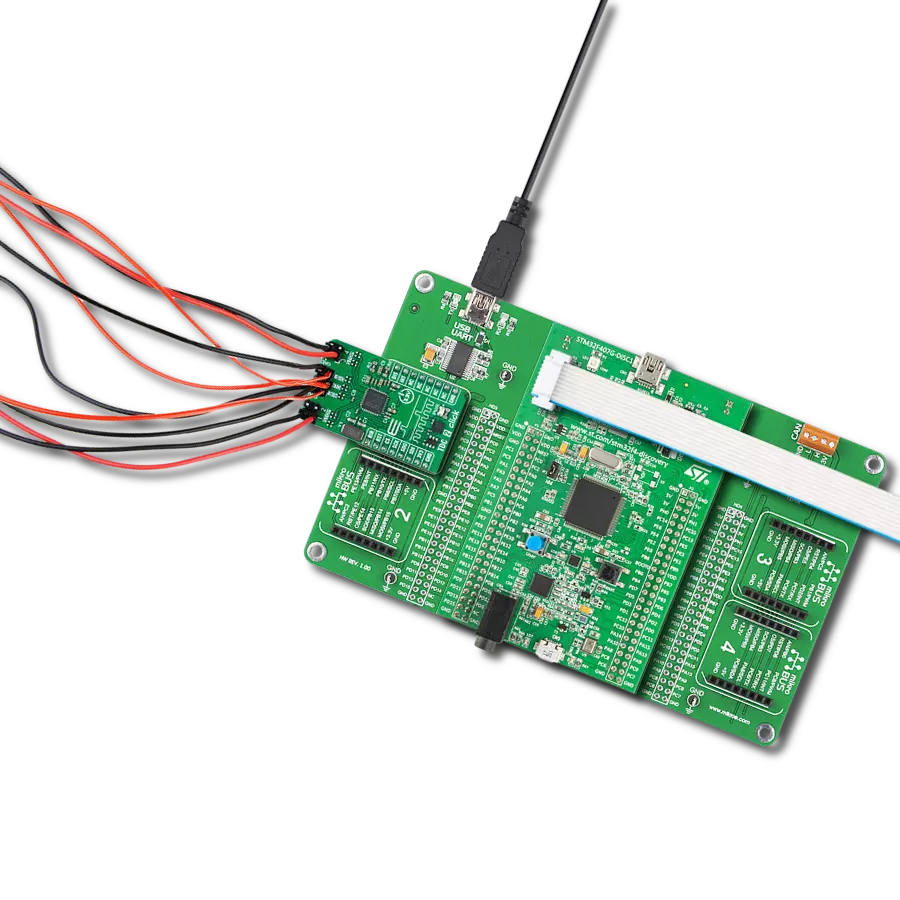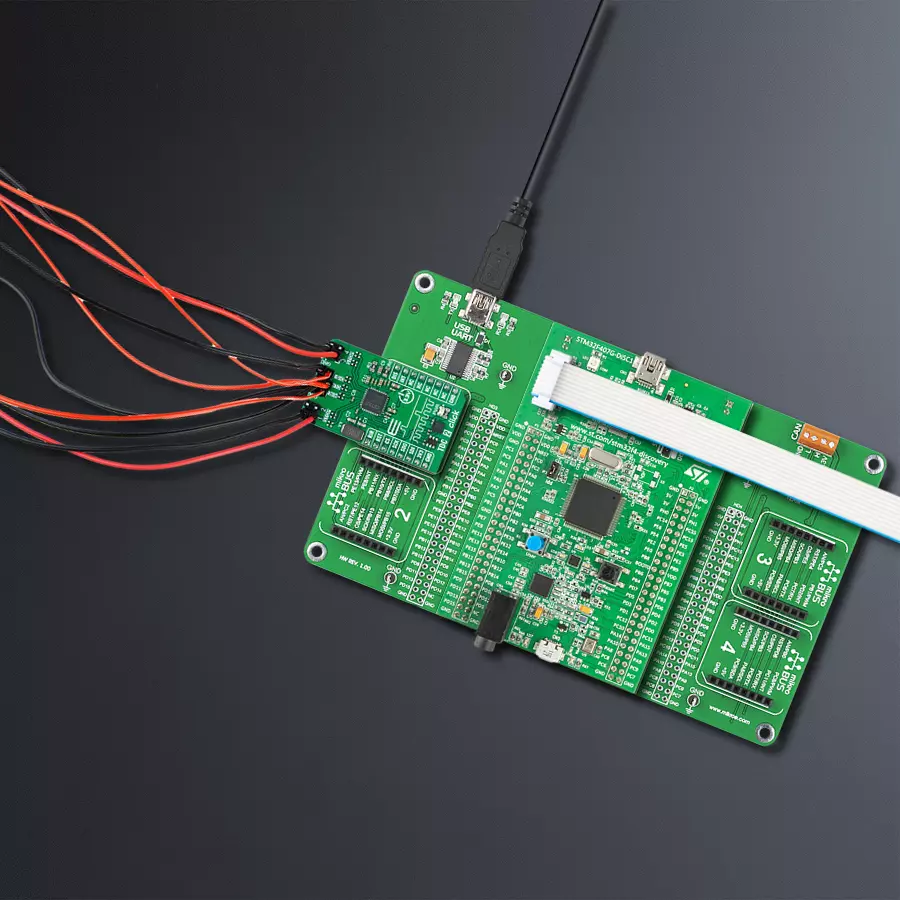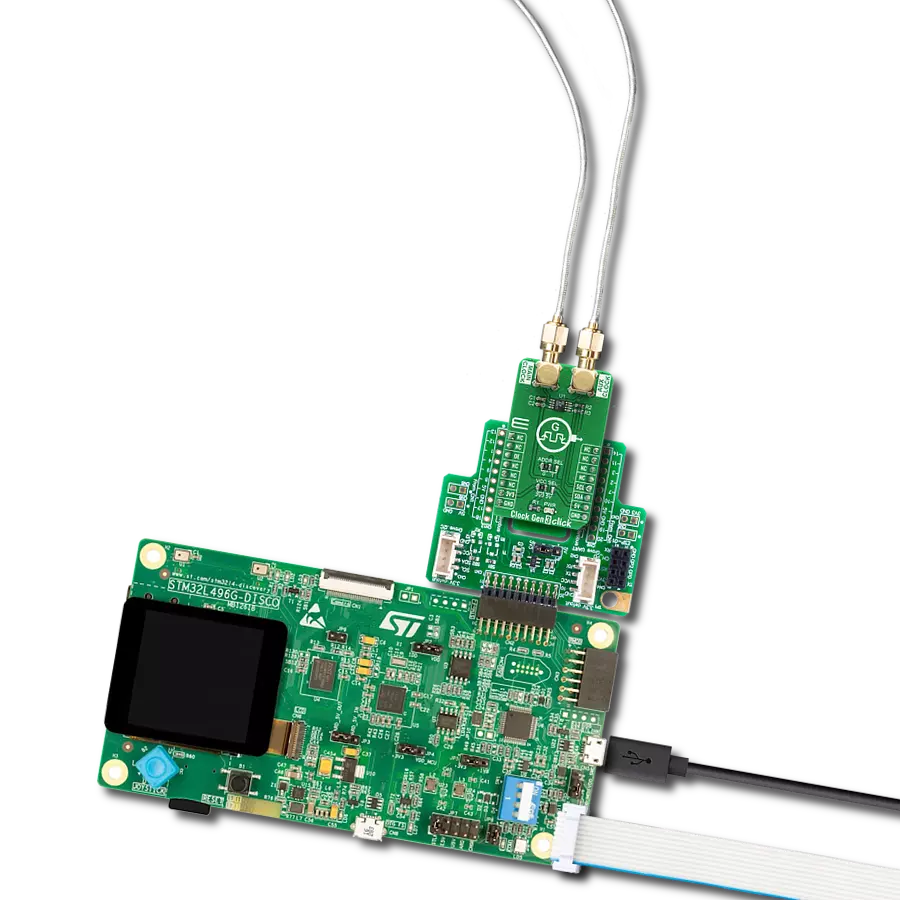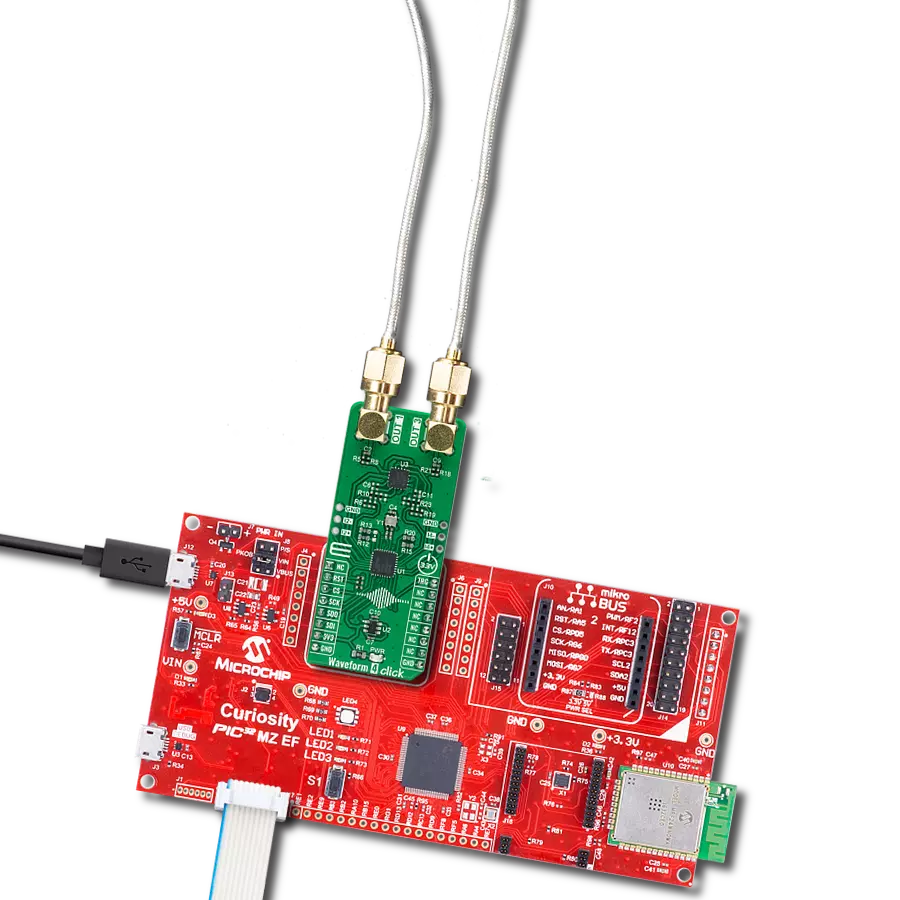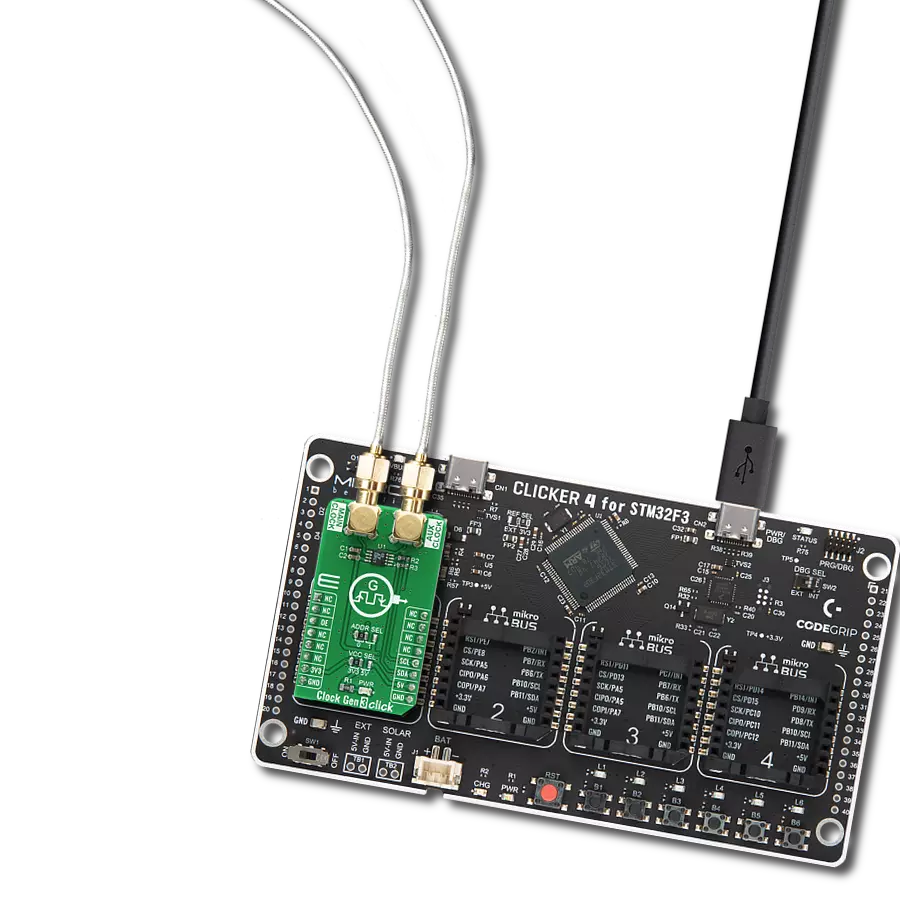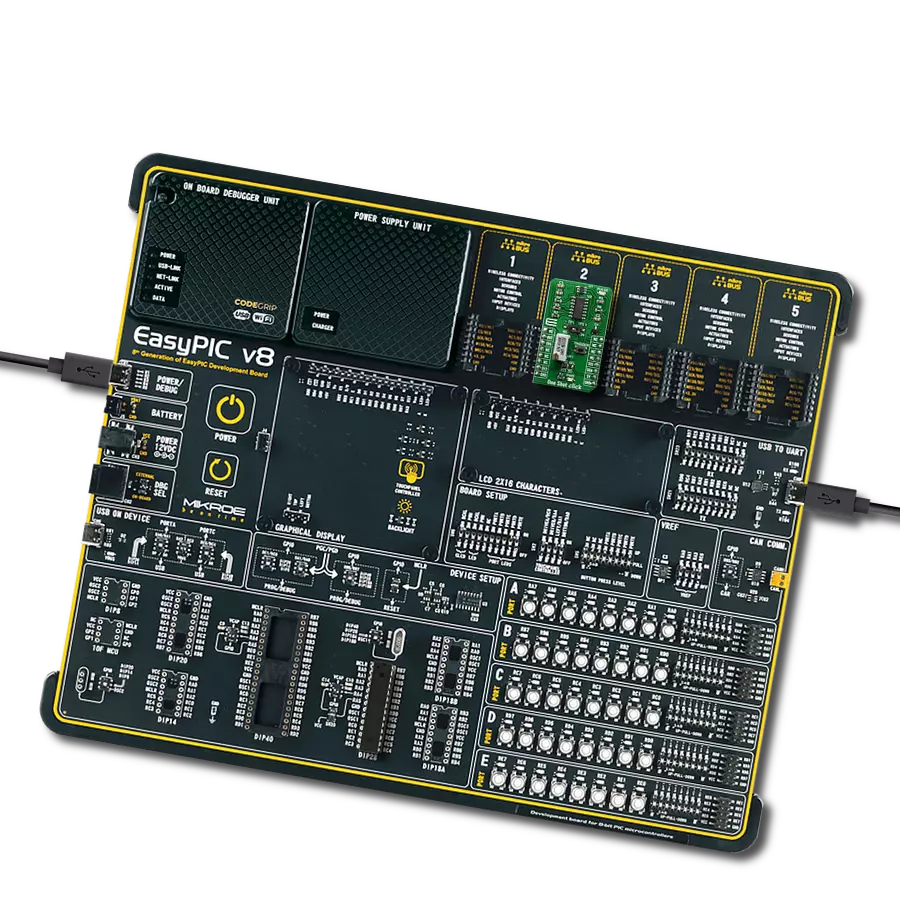Unleash the boundless possibilities of this high-performance time-to-digital converter today
A
A
Hardware Overview
How does it work?
TDC 2 Click is based on the AS6500, a high-resolution time-to-digital converter from ScioSense, featuring CMOS inputs, high measurement performance, and high data throughput. The AS6500 can measure time intervals as low as 5ns with 10ps resolution on all four STOP channels at a sampling rate of up to 1.5Ms/s. It is characterized by high configuration flexibility, a wide measurement range from 0 to 16s, and simple data post-processing thanks to calibrated results. It calculates calibrated stop measurements referenced to the applied reference clock. This Click board™ is ideal for optical applications, including general-purpose laser distance measurement in 1D, 2D, and 3D, speed control, object recognition, time-of-flight spectroscopy, and many more. The positive edges of the stop signals, applied on the STOP terminals (1-4), are measured versus the preceding reference clock edge. The reference clock can be brought externally via the CLR
pin on the middle header terminal or from the onboard 8MHz quartz oscillator. This feature is selectable through software – register-setting. The reference clock represents the framework for all time measurements and serves as a universal time base. The TDC measures the clock pulses continuously as a time reference point for STOP pulses and an internal reference period. The measurement of the STOP events always refers to the preceding reference clock. The reference clock is counted continuously, and the actual count is assigned as a reference index to a STOP pulse. TDC 2 Click communicates with the host MCU through a standard SPI interface to read data and configure the frontend, supporting high clock speed up to 50MHz and the most common SPI mode, SPI Mode 1. SPI pins also use an interrupt pin that indicates to the host MCU that data are available and ready for processing. The AS6500 uses several more signals available on the
mikroBUS™ socket for successful time measurements. With the RIR pin, the internal counter for the reference index is set back to zero, simplifying the overview of the reference index in the output data stream. Next, setting the disable pin, marked as DIS, to a high logic state, the measurements on all four stops are disabled. On the other hand, the reference clock is not affected, and internal reference measurements are continued. Apart from the mikroBUS™ socket, these signals can also be found on the middle header, grouped with the reference clock pin. This Click board™ can only be operated with a 3.3V logic voltage level. The board must perform appropriate logic voltage level conversion before using MCUs with different logic levels. However, the Click board™ comes equipped with a library containing functions and an example code that can be used as a reference for further development.
Features overview
Development board
Discovery kit with STM32F407VG MCU, powered by the STM32F407 microcontroller, simplifies audio application development. It offers a robust platform with features like the ST-LINK/V2-A debugger, STMEMS digital accelerometer, digital microphone, and integrated audio DAC with a class D speaker driver. It has LEDs, push buttons, and a USB OTG
Micro-AB connector for versatile connectivity. The STM32F407VGT6 MCU boasts a 32-bit Arm Cortex-M4 with FPU, 1MB Flash memory, and 192KB RAM, housed in an LQFP100 package. Equipped with USB OTG FS, MEMS accelerometer, omnidirectional digital microphone, and user-friendly buttons, it ensures seamless operation.
The board accommodates various add-ons via extension headers while offering flexible power supply options, including ST-LINK, USB VBUS, or external sources. Supported by comprehensive free software and a range of IDEs, it empowers developers with flexibility and ease of use, making it an ideal choice for audio-centric projects.
Microcontroller Overview
MCU Card / MCU
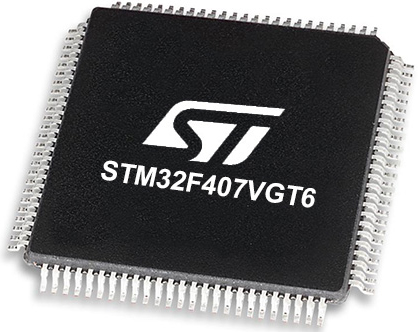
Architecture
ARM Cortex-M4
MCU Memory (KB)
10
Silicon Vendor
STMicroelectronics
Pin count
100
RAM (Bytes)
100
You complete me!
Accessories
STM32F4 Discovery Shield is the perfect extension for your STM32F4 Discovery Board from STMicroelectronics. This versatile shield features four mikroBUS™ host sockets, a USB-UART module, and a CAN transceiver, expanding the capabilities of your Discovery board. Acting as a docking station, the STM32F4 Discovery Shield enables you to effortlessly transform your board into various applications, whether it's an RFID lock, SMS-triggered control switch, GPS tracking device, full-blown weather station, or any other idea you have in mind. With its seamless integration and enhanced functionality, this shield empowers you to explore endless possibilities and quickly bring your projects to life.
Used MCU Pins
mikroBUS™ mapper
Take a closer look
Click board™ Schematic

Step by step
Project assembly
Track your results in real time
Application Output
1. Application Output - In Debug mode, the 'Application Output' window enables real-time data monitoring, offering direct insight into execution results. Ensure proper data display by configuring the environment correctly using the provided tutorial.

2. UART Terminal - Use the UART Terminal to monitor data transmission via a USB to UART converter, allowing direct communication between the Click board™ and your development system. Configure the baud rate and other serial settings according to your project's requirements to ensure proper functionality. For step-by-step setup instructions, refer to the provided tutorial.

3. Plot Output - The Plot feature offers a powerful way to visualize real-time sensor data, enabling trend analysis, debugging, and comparison of multiple data points. To set it up correctly, follow the provided tutorial, which includes a step-by-step example of using the Plot feature to display Click board™ readings. To use the Plot feature in your code, use the function: plot(*insert_graph_name*, variable_name);. This is a general format, and it is up to the user to replace 'insert_graph_name' with the actual graph name and 'variable_name' with the parameter to be displayed.

Software Support
Library Description
This library contains API for TDC 2 Click driver.
Key functions:
tdc2_read_resultsTDC 2 results data reading function.tdc2_start_measuringTDC 2 start measuring function.tdc2_set_resolutionTDC 2 set resolution function.
Open Source
Code example
The complete application code and a ready-to-use project are available through the NECTO Studio Package Manager for direct installation in the NECTO Studio. The application code can also be found on the MIKROE GitHub account.
/*!
* @file main.c
* @brief TDC 2 Click example
*
* # Description
* This library contains API for TDC 2 Click driver.
* The library initializes and defines the SPI bus drivers to
* write and read data from registers, as well as the default
* configuration for a reading time between two STOP signals.
*
* The demo application is composed of two sections :
*
* ## Application Init
* Initializes the driver after that resets the device and
* performs default configuration and sets the device in read mode.
*
* ## Application Task
* This example demonstrates the use of the TDC 2 Click board by
* measuring the time between two STOP signals. This example is set up to
* generate stop signals until FIFO fil's up which is indicated by interrupt pin going to low state.
* After that FIFO buffer is completely emptied by reading, and that data is used to calculate
* the time between STOP signals.
*
* @note
* In order to test this example, you will need to connect STOP1 with the DIS pin. Disable pin is
* disabled by software and it isn't going to affect the working state of the TDC 2 Click Bord.
*
* @author Stefan Ilic
*
*/
#include "board.h"
#include "log.h"
#include "tdc2.h"
static tdc2_t tdc2;
static log_t logger;
/**
* @brief Dev generate stop signal function.
* @details This function generates the stop signal by toggling DIS pin.
* @param[out] cfg : Click configuration structure.
* See #tdc2_cfg_t object definition for detailed explanation.
* @return Nothing.
* @note DIS pin ( Disable STOP channels) is disabled by software and isn't affecting the example.
*/
void dev_generate_stop( tdc2_t *ctx );
void application_init ( void )
{
log_cfg_t log_cfg; /**< Logger config object. */
tdc2_cfg_t tdc2_cfg; /**< Click config object. */
/**
* Logger initialization.
* Default baud rate: 115200
* Default log level: LOG_LEVEL_DEBUG
* @note If USB_UART_RX and USB_UART_TX
* are defined as HAL_PIN_NC, you will
* need to define them manually for log to work.
* See @b LOG_MAP_USB_UART macro definition for detailed explanation.
*/
LOG_MAP_USB_UART( log_cfg );
log_init( &logger, &log_cfg );
log_info( &logger, " Application Init " );
// Click initialization.
tdc2_cfg_setup( &tdc2_cfg );
TDC2_MAP_MIKROBUS( tdc2_cfg, MIKROBUS_1 );
if ( SPI_MASTER_ERROR == tdc2_init( &tdc2, &tdc2_cfg ) )
{
log_error( &logger, " Communication init." );
for ( ; ; );
}
if ( TDC2_ERROR == tdc2_default_cfg ( &tdc2 ) )
{
log_error( &logger, " Default configuration." );
for ( ; ; );
}
tdc2_start_measuring ( &tdc2 );
log_info( &logger, " Application Task " );
}
void application_task ( void )
{
uint32_t reference_index [ 18 ] = { 0 };
uint32_t stop_result [ 18 ] = { 0 };
uint8_t cnt = 0;
tdc2_reset_index( &tdc2 );
Delay_ms ( 10 );
while ( tdc2_get_int_state( &tdc2 ) == 1 )
{
dev_generate_stop( &tdc2 );
Delay_ms ( 100 );
}
while ( tdc2_get_int_state( &tdc2 ) == 0 )
{
tdc2_read_results( &tdc2, TDC2_REG_INDEX_CH1_BYTE3, &reference_index[ cnt ], &stop_result[ cnt ] );
log_printf( &logger, "CH1: Reference Index[%d]: %lu, Stop Result[%d]: %lu \r\n", ( uint16_t ) cnt,
reference_index[ cnt ], ( uint16_t ) cnt, stop_result[ cnt ] );
Delay_ms ( 10 );
if ( cnt )
{
uint32_t time = 0;
tdc2_get_time_between_stops ( &tdc2, stop_result[ cnt - 1 ], reference_index[ cnt - 1 ],
stop_result[ cnt ], reference_index[ cnt ], &time );
log_printf( &logger, "Time between STOP %d and STOP %d is %lu ms \r\n",
( uint16_t ) ( cnt - 1 ), ( uint16_t ) cnt, time / TDC2_uS_TO_mS );
Delay_ms ( 10 );
}
cnt++;
}
log_printf( &logger, "---------------------------------------------- \r\n" );
}
int main ( void )
{
/* Do not remove this line or clock might not be set correctly. */
#ifdef PREINIT_SUPPORTED
preinit();
#endif
application_init( );
for ( ; ; )
{
application_task( );
}
return 0;
}
void dev_generate_stop( tdc2_t *ctx )
{
digital_out_high( &ctx->dis );
Delay_ms ( 1 );
digital_out_low( &ctx->dis );
}
// ------------------------------------------------------------------------ END
